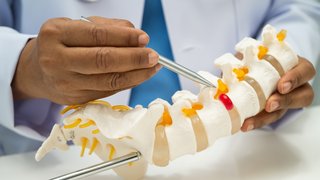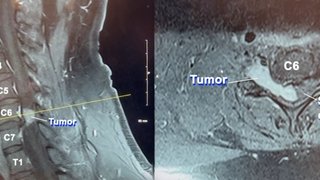Solving the back pain puzzle, one spine area at a time
July 20, 2022

When your back hurts, it can affect all aspects of your life – from working at home or in the office to playing golf on weekends or even doing household chores. Daily activities such as driving, climbing steps, and sleeping become a struggle.
Pinpointing the source of your pain – and designing an effective treatment plan – begins with the knowledge that it may not be your back at all that is causing the problem.
Muscle tension, microtears in tendons or ligaments, and joint injuries from the shoulders to the hips and knees can cause pain throughout the spine. Even medical conditions such as gallbladder disease and kidney stones can initially present with back pain.
Unfortunately, misdiagnoses can cost patients time, energy, and money for procedures that might not address the root cause of their symptoms. The back pain experts on UT Southwestern’s Spine Center and Physical Medicine and Rehabilitation (PM&R) teams often meet with patients who’ve had multiple back surgeries elsewhere, only to discover that a joint or musculoskeletal problem was to blame all along.
Because of the range of causes for spine pain, we take an interdisciplinary approach to precisely diagnose and treat the cause of your symptoms. Using advanced tests and imaging technology, we investigate all potential problem areas – from the upper and lower back regions to your shoulders and neck – to locate the true source of your pain and get you back on track quickly.

Upper back pain causes
Upper back pain tends to be less common than lower back pain – but that doesn’t make it any less frustrating.
When more people started working remotely during the pandemic, we began to see more cases of upper back pain due to poor posture. Makeshift home offices often don’t have the best ergonomics for a full day’s work, let alone weeks and months.
Sitting for long periods of time at your desk or hunching forward to look at your phone can cause structural changes in the upper back and neck. That forward-bending posture puts additional pressure on the bones, discs, muscles, and ligaments of the upper spine.
Related reading: Can a standing desk help my back pain?
What might cause pain on the upper left and right side?
Problems originating in the shoulder can cause pain in the upper back.
- Rotator cuff tears: Associated with overuse, these small tears in the tissues that connect your shoulder joint to the surrounding muscle are among the most common injuries that cause upper back pain.
- Bursitis: This condition develops when the fluid-filled sac that cushions a joint becomes inflamed due to frequent repetitive motions, such as swinging a bat or lifting heavy objects overhead. Bursitis can cause radiating pain in the arm and pain sensation in the upper back with movement.
- Scapular dyskinesis: Characterized by abnormal positioning of the shoulder blade during movement, this condition can cause upper back pain, too.
Some conditions that are unrelated to the spine can cause upper back pain – a phenomenon called referred pain. Gallbladder disease, for example, is characterized by increasing pain in the upper right abdomen that can radiate to the upper back.
Related reading: Easy tips to relieve stress-related neck and back pain
Low-back pain causes
Approximately 80% of people will experience low-back pain at some point in their lives. Common spine-related conditions that can cause low-back pain include:
- Arthritis
- Bulging or ruptured discs (the cushions between the bones in your spine)
- Disc degeneration
- Osteoporosis
- Pinched nerves
- Scoliosis
- Torn or pulled muscles or ligaments
- Vertebrogenic pain, which is nerve pain that starts inside the vertebrae
What might cause pain on the lower left or right side?
It’s not unusual for us to see patients who were diagnosed with a lower back condition that has not improved, only to discover the problem is actually in their hips or pelvis.
Your lower back, hips, and pelvis are codependent, so a problem in one can cause pain in the others. Problems with the sacroiliac joint, which links your pelvis to your lower spine, or bursitis of the hip also can cause low-back pain.
We sometimes see low-back pain on one side as a result of an injury on the other side. The body tends to overcompensate – for example, if you injure your left ankle and need to wear a walking boot, you may notice hip or back pain on your right side due to adjusting your posture.
Conditions that can cause referred low-back pain include appendicitis, kidney stones, and urinary tract infections. Pain may be sudden and severe, occurring on one or both sides of the lower back.
Related reading: Golfer’s guide: 5 ways to avoid back pain
At-home treatments, and when to see a doctor
For mild back pain, or pain that you know was caused by a specific activity, there’s usually no need to rush to the doctor. Musculoskeletal pain typically starts improving in four to six weeks with rest and conservative treatment, such as taking ibuprofen or applying ice and heat to the tender areas.
However, if your pain does not resolve or if it gets worse, schedule an appointment with a spine specialist or PM&R expert. We can pinpoint the cause and create a plan to help you feel better.
Call the doctor right away if you experience any of these symptoms, which may indicate a spine- or nerve-related medical emergency:
- Sharp pain that appears suddenly and can’t be associated with a specific activity or injury
- Pain that keeps you from sleeping or performing everyday activities
- Radiating pain that shoots into the glutes or legs
- Sudden weakness in the legs
- Numbness or pins and needles in the groin or glutes
- Pain that is accompanied by fever, unintentional weight loss, or bowel or bladder changes
Staying active can prevent and heal back pain
Having chronic back pain can make it tough to move – but movement is key to reducing pain and preventing future flare-ups for a range of spine conditions.
In 2017, the American College of Physicians and the American Pain Society updated its back pain treatment guidelines, which emphasize movement as a first-line treatment and de-emphasize going straight to surgery or strong medications.
UT Southwestern has followed a similar philosophy for decades, reserving surgery for the most severe or complex spine cases. When conservative treatments are not enough to relieve back pain – or in cases where no other treatment is proven effective – you may be a candidate for back surgery.
Some conditions we treat with spine surgery include:
- Degenerated disc disease: Breakdown of the discs over time, which we can treat with corpectomy or diskectomy to remove the discs.
- Herniated discs: Damaged discs, which also are treated with corpectomy or diskectomy.
- Spinal stenosis: Narrowing of the space within the spinal column, which can be treated with decompression surgery (laminectomy).
- Spinal fractures: Broken bones within the spine, which may be repaired or removed, depending on their location and the severity of the injury.
- Spondylolisthesis: In this condition, a vertebra slides out of position and crowds surrounding vertebrae. Spinal fusion surgery can provide stability, and we may place bone grafts between the vertebrae to promote the growth of new, healthy bone.
- Kyphosis or scoliosis: If bracing and physical therapy are not enough to straighten the spine, spinal fusion surgery can help realign and strengthen the spine as it heals into a straighter, solid shape.

However, most patients can control or prevent back pain by following a few steps every day:
- Pay attention to your posture by standing and sitting up straight.
- Warm up with some easy stretches before activity or exercise to prevent injuries.
- Use proper mechanics when performing specific movements, such as lifting with your legs and not your back.
- Perform core strength exercises to provide additional support to the lower back, improve posture, and reduce strain on the spine.
- Practice yoga or another form of fluid stretching to improve flexibility of the muscles and ligaments in the back.
- Get aerobic exercise to increase blood flow and nutrients to the tissues in the back, speed up healing, and reduce stiffness that can lead to back pain.
Related reading: 10 alternative back pain treatments to try before surgery
While long-term back health relies on you staying active, it’s easy to get motivated and overdo it – especially if you’ve been sedentary awhile. Remember, “moderation” is not a bad word. If a muscle or tendon doesn’t feel right, reduce your effort or intensity, or try a new activity.
No matter where in your back it hurts – the upper, lower, or in between – seeing a back pain expert is a good first step toward enjoying more pain-free days.
If you or a loved one could benefit from a back pain evaluation, call 214-645-8300 or request an appointment online.












